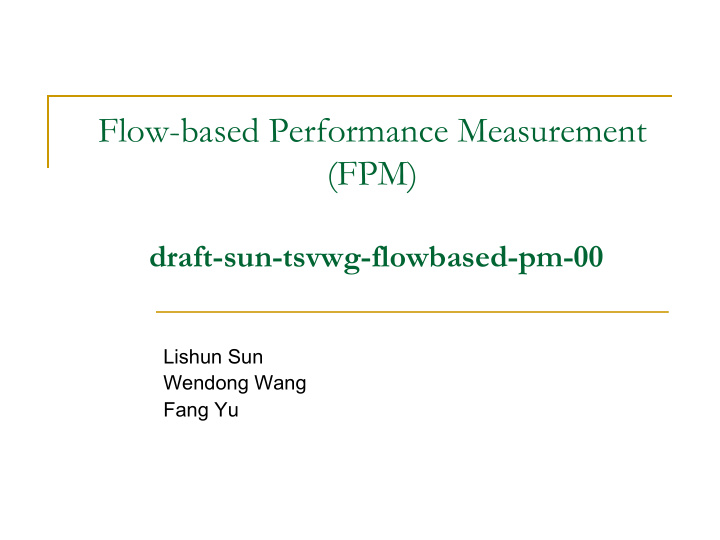



Flow-based Performance Measurement (FPM) draft-sun-tsvwg-flowbased-pm-00 Lishun Sun Wendong Wang Fang Yu
Requirements Overview IP Performance Monitoring based on flow/applications is needed in many n cases. For mobile operator’s backhaul network, the applications are devided into n multiple bearers with proper mobile QoS parameters (e.g. QCI). If the mobile network would manage bearers as QoS and applications, then the performance of backhaul is more like to be based on applications or QoS. Currently there is no appropriate approach to monitor/test IP performance n for separate applications. In addition, in some cases, it needs to monitor the various time-varying n performance indexes of the IP network, the performance measurement should be based on real service stream and reflect the real performance of the network. The average performance indexes measured by the active measurement method may not be suitable in these cases. Page 2
Protocol Overview n This is an end-to-end flow-based IP performance monitoring method: It can support on-the-spot measurement. q OAM packets are injects to the network to carry some parameters related to q service flow and some statistic information. The OAM packets are processed using the same method as its q corresponding service flow. The measurement statistics are Delay, Jitter, Loss rate and Bandwidth. q n It involves three steps: Connection Activation q Establish a connection between PM Initiator and PM Responder ü Define flow according to a certain method ü Configure parameters (e.g. period of measurement packets, Flow ID) ü Measurement Process q Connection Deactivation q Page 3
Connection Activation-Definition of Flow n In the IPPM connection activation process, a unique Flow ID is assigned to a connection between the PM Initiator and the PM Responder for a defined flow. n Flow can be defined by different combinations of SIP, DIP, PT, DSCP, sPort and dPort : q Flow can be defined by: (SIP, DIP, PT) p (SIP, DIP, PT, DSCP) p (SIP, DIP, PT, sPort, dPort) p q The more the combinational dimensions are, the more fine-grained can be the monitoring of data flow. Page 4
Measurement Process-Typical process PM PM Initiator Responder ACT ACT -ACK ACT: FM BR FM BR . . . FM BR DEA FM: DEA-ACK BR:
Statistics ( ) ( ) [ ] [ ] [ ] [ ] i i i i 1 M N 1 T T T T + − − − − [ ] [ ] i Delay i 4 1 3 2 avrDelay Delay ∑ Delay , = = n { N , M } 2 N i M = N j ∑ M N 1 1 + − 2 ( ) p [ ] i pdv Delay avrDelay n Jitter , ∑ = − p 1 J = { N , M } = N D N i M = n Loss Lost Packet = (SPN(M) - SPN(M - 1) ) - (RPN(M) - RPN(M - 1) ) q Lost Packet Rate = ((SPN(M) - SPN(M - 1) ) - (RPN(i) - RPN(M - 1) ))/ (SPN(M) - SPN(M - q 1) )
Exception Handling can be obtained from this round of measurement, then loss rate of the In some cases the FM or BR packet may be lost in transit, no statistics mth measurement can be calculated as: n - 1) ) (note: M is the SN of the BR packet currently received and N is the SN of the Lost Packet Rate = ((SPN(M) - SPN(M - 1) ) - (RPN(i) - RPN(M - 1) ))/ (SPN(M) - SPN(M latest BR received.) n Packets Mis-ordering q Reasons for packets mis-ordering: n the extra time spent on the IP fragment reassembly. n packets. Some load sharing schemes for network (e.g. ECMP, ML-PPP) may create multipath for Multi-core CPU processing and multi-threading of packets in the sender and receiver. q Solutions n classify the flow in order to avoid the packet reordering. In the simplest case that data transmits along a single path, DSCP can be used to period, the error caused by the occasional packet reordering can be smoothed. The packet loss calculation is based on sample statistic, by increasing the monitoring Page 7
Thank you
Recommend
More recommend